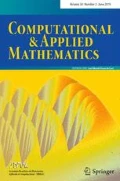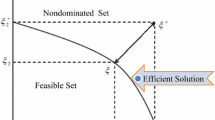Abstract
In this communication, we propose a generalized fuzzy knowledge measure and prove its efficiency by comparing it with some existing entropies. We also propose a generalized fuzzy accuracy measure and show some of its properties. This accuracy measure may serve as a compatibility measure between two fuzzy sets and helpful in some specific situations. We introduce a generalized fuzzy knowledge and accuracy measure-based TOPSIS for multiple-attribute decision-making problems and presents its comparison with MOORA method, VIKOR method, and a compromise-type variable weight decision-making method. The application of the proposed TOPSIS approach in multiple-attribute decision-making (MADM) is demonstrated using a numerical example. We also investigate the application and efficiency of the generalized fuzzy accuracy in pattern recognition problems.

Similar content being viewed by others
References
Akram M, Adeel A (2019a) TOPSIS approach for MAGDM based on interval-valued hesitant fuzzy N-soft environment. Int J Fuzzy Syst 21:993–1009
Akram M, Adeel A (2019b) Novel TOPSIS method for group decision-making based on hesitant m-polar fuzzy model. J Intell Fuzzy Syst 37:8077–8096
Akram M, Al-Kenani AN (2020b) Multi-criteria group decision-making for selection of green suppliers under bipolar fuzzy PROMETHEE process. Symmetry 12:77
Akram M, Arshad M (2020) Bipolar fuzzy TOPSIS and bipolar fuzzy ELECTRE-I methods to diagnosis. Computational and Applied Mathematics 39:1–21. https://doi.org/10.1007/s40314-019-0980-8
Akram M, Ilyas F, Garg H (2020) Multi-criteria group decision making based on ELECTRE I method in pythagorean fuzzy information. Soft Comput 24:3425–3453
Bajaj RK, Hooda DS (2010a) On some new generalized measures of fuzzy information. World Acad Sci 38:747–753
Bajaj RK, Hooda DS (2010b) Generalized measures of fuzzy directed divergence, total ambiguity and information improvement. JAMSI 6:31–44
Bhatia PK, Singh S (2013) On some divergence measures between fuzzy sets and aggregation operators. Adv Model Optim 15:235–248
Boron FE, Gene S, Kurt M, Akay D (2009) A multi-criteria intuitionistic fuzzy group decision making for supplier selection with TOPSIS method. Expert Syst Appl 36:11363–11368
Brauers WKM, Zavadskas EK (2006) The MOORA method and its application to privatization in a transition economy. Control Cybern 35(2):445–469
Chen T, Li C (2010) Determining objective weights with intuitionistic fuzzy entropy measures: a comparative analysis. Inf Sci 180:4207–4222
Chu ATW, Kalaba RE, Spingarn K (1979) A comparison of two methods for determining the weights of belonging to fuzzy sets. J Optim Theory Appl 27:531–538
De Luca A, Termini S (1971) A definition of non-probabilistic entropy in the setting of fuzzy set theory. Inf Control 20:301–312
De SK, Biswas R, Roy AR (2000) Some operations on intuitionistic fuzzy sets. Fuzzy Sets Syst 114:477–484
Fan J, Xie W (1999) Distance measure and induced fuzzy entropy. Fuzzy Sets Syst 104:305–314
Guo K (2016) Knowledge measure for Atanassov’s intuitionistic fuzzy sets. IEEE Trans Fuzzy Syst 24:1072–1078
Hooda, D.S. (2004).On generalized measures of fuzzy entropy. Mathematica Slovaca, 51,315-325
Hung WL, Yang MS (2006) Fuzzy entropy on intuitionistic fuzzy sets. Int J Intell Syst 21:443–451
Hwang CH, Yang MS (2008) On entropy of fuzzy sets. Int J Uncertain Fuzzy Knowl Based Syst 16:519–527
Hwang CH, Yoon K (1981) Methods for Multiple Attribute Decision Making. In: Multiple attribute decision making. Lecture Notes in Economics and Mathematical Systems. Springer, Berlin, 186
Joshi R, Kumar S (2017a) An (R, S)-norm fuzzy information measure with its applications in multiple-attribute decision-making. Comput Appl Math., https://doi.org/10.1007/s40314-017-0491-4
Joshi R, Kumar S (2017b) A new exponential fuzzy entropy of order (α,β) and its application in multiple attribute decision making problems. Commun Math Stat 5:213–229
Joshi R, Kumar S (2018a) An exponential Jensen fuzzy divergence measure with applications in multiple attribute decision-making. Math Probl Eng. https://doi.org/10.1155/2018/4342098
Joshi R, Kumar S (2018b) An (R’, S’)-norm fuzzy relative information measure and its applications in strategic decision-making. Comput Appl Math 37:4518–4543
Kosko B (1986) Fuzzy entropy and conditioning. Inf Sci 10:165–171
Lad F, Sanfilippo G, Agro G (2015) Entropy: complementary dual of entropy. Stat Sci 30:40–58
Lalotra S, Singh S (2018) On a Knowledge measure and unorthodox accuracy measure of an intuitionistic fuzzy set(s) with their applications. Int J Comput Intell Syst 11(1):1338–1356
Lee AHI, Kang HY, Hsu CF, Hung HC (2009) A green supplier selection model for high tech industry. Expert Syst Appl 36:7917–7927
Li P, Liu B (2008) Entropy credibility distributions for fuzzy variables. IEEE Trans Fuzzy Syst 16:123–129
Li HX, Li LX, Wang JY (2004) Fuzzy decision making based on variable weights. Math Comput Model 39:163–179
Li DF, Chen GH, Huang ZG (2010) Linear programming method for multi-attribute group decision making using IF sets. Inf Sci 180:1591–1609
Li Y, Qin K, He X (2014) Some new approaches to constructing similarity measures. Fuzzy Sets Syst 234:46–60
Liang D, Xu Z, Liuc D, Wu Y (2018) Method for three-way decisions using ideal TOPSIS solutions at Pythagorean fuzzy information. Inf Sci 435:282–295
Liu M, Ren H (2014) A new intuitionistic fuzzy entropy and application in multi-attribute decision-making. Inf Sci 5:587–601
Lu J, Tang X, Wei G, Wei C, Wei Y (2019) Bidirectional project method for dual hesitant Pythagorean fuzzy multiple attribute decision-making and their application to performance assessment of new rural construction. Int J Intell Syst 34:1920–1934
Lubbe V (1981) A generalized probabilistic theory of the measurement of certainty and information. Doctoral thesis, Faculty of Electrical Engineering, Mathematics and Computer Science, Delft University of Technology
Ohlan A (2017) A novel generalized divergence measure of fuzzy sets. Int J Curr Res Rev 9:1–3
Opricovic, S. (1998). Multi-criteria Optimization in Civil Engineering (in Serbian). Faculty of Civil Engineering, Belgrade, -302, ISBN 86-80049-82-4
Pal NR, Pal SR (1989) Object background segmentation using new definition of entropy. Proc Inst Electron Eng 136:284–295
Pal NR, Pal SR (1992) Higher order fuzzy entropy and hybrid entropy of a set. Inf Sci 61:211–231
Papathanasiou J, Ploskas N (2018) VIKOR. In: Multiple Criteria Decision Aid. Springer Optimization and Its Applications, 136, 31-55
Pappis C, Karacapilidis I (1993) A comparative assessment of measures of similarity of fuzzy values. Fuzzy Sets Syst 56:171–174
Roszkowska E, Wachowicz T (2015) Application of fuzzy TOPSIS to scoring the negotiation offers in ill-structured negotiation problems. Eur J Oper Res 242:920–932
Saaty TL (1980) The analytic hierarchy process. McGraw Hill, New York
Salih MM, Zaidan BB, Zaidan AA, Ahmed MA (2019) Survey on fuzzy TOPSIS state-of-the-art between 2007 and 2017. Comput Oper Res 104:207–227
Shannon CE (1948) A mathematical theory of communication. The Bell Systems Technical Journal 27(379–423):623–656
Singh S, Lalotra S (2019) On generalized correlation coefficients of the hesitant fuzzy sets with their application to clustering analysis. Comput Appl Math 38:11. https://doi.org/10.1007/s40314-019-0765-0
Singh S, Lalotra S, Sharma S (2019) Dual concepts in fuzzy theory: entropy and knowledge measure. Int J Intell Syst 34:1034–1059
Szmidt E, Kacprzyk J, Buinowski P (2014) How to measure amount of knowledge conveyed by Atanassov’s intuitionistic fuzzy sets. Inf Sci 7:276–285
Verma R, Sharma BD (2011) On generalized exponential fuzzy entropy. World Acad Sci Eng Technol Int J Math Comput Sci 5:1895–1898
Wan SP, Li DF (2013) Fuzzy LINMAP approach to heterogeneous MADM considering comparisons of alternatives with hesitation degrees. Omega 41:925–940
Wang PZ (1985) Fuzzy Sets and the Falling Shadow of Random Sets (in Chinese). Beijing Normal Univ. Press, Beijing
Wang WJ (1997) New similarity measures on fuzzy sets and on elements. Fuzzy Sets Syst 85:305–309
Wang TC, Lee HD (2009) Developing a fuzzy TOPSIS approach based on subjective weights and objective weights. Expert Syst Appl 36:8980–8985
Wang J, Wei G, Wei C, Wei Y (2019) Dual Hesitant q-Rung Orthopair Fuzzy Muirhead Mean Operators in Multiple Attribute Decision Making. IEEE Access
Wu T, Liu X, Liu F (2018) An interval type-2 fuzzy TOPSIS model for large scale group decision making problems with social network information. Inf Sci 432:392–410
Wu Z, Xu J, Jiang X, Zhong L (2019a) Two MAGDM models based on hesitant fuzzy linguistic term sets with possibility distributions: VIKOR and TOPSIS. Inf Sci 473:101–120
Wu L, Wang J, Gao H (2019b) Models with competitiveness evaluation of tourist destination with some interval valued intuitionistic fuzzy Hammy mean operator. J Intell Fuzzy Syst 36:5693–5709
Xia M, Xu Z (2012) Entropy/cross entropy-based group decision making under intuitionistic fuzzy environment. Inf Fusion 13:31–47
Yager RR (1979) On the measure of fuzziness and negation Part 1: membership in the unit interval. Int J Genetic Syst 5:221–229
Yang Y, Peng X (2017) A revised TOPSIS method based on interval fuzzy soft set models with incomplete weight information. Fund Inf 152:297–321
Yu GF, Li DF, Liu WQ (2017) Method for incentive type variable weight decision making considering decision maker’s psychological behavioral character. Syst Eng Theory Pract 37:1304–1312
Yu GF, Fei W, Li DF (2019) A compromise-typed variable weight decision method for hybrid multi-attribute decision making. IEEE Trans Fuzzy Syst 27:861–872
Zadeh LA (1965) Fuzzy sets. Inf Control 8:338–353
Zadeh LA (1972) A fuzzy-set-theoretic interpretation of linguistic hedges. J Cybern 28:4–34
Zhang Y, Zhang Y, Li Y, Liu S, Yang J (2017) A study of rural logistics center location based on intuitionistic fuzzy TOPSIS. Math Probl Eng. https://doi.org/10.1155/2017/2323057
Zheng X, Lin H, Liu Z, Li D, Llopis-Albert C, Zeng S (2018) Manufacturing decisions and government subsidies for electric vehicles in China: a maximal social welfare perspective. Sustainability 10:672
Zheng XX, Li DF, Liu Z, Jia F, Sheu JB (2019) Coordinating a closed-loop supply chain with fairness concerns through variable-weighted Shapley values. Transp Res Part E: Log Transp Rev 126:227–253
Acknowledgements
The authors would like to thank the editor and anonymous referees for their helpful and constructive suggestions to bring this paper in the present form.
Author information
Authors and Affiliations
Corresponding author
Ethics declarations
Conflict of interest
We declare that authors have no conflict of interest.
Additional information
Communicated by Anibal Tavares de Azevedo.
Publisher's Note
Springer Nature remains neutral with regard to jurisdictional claims in published maps and institutional affiliations.
Rights and permissions
About this article
Cite this article
Singh, S., Sharma, S. & Ganie, A.H. On generalized knowledge measure and generalized accuracy measure with applications to MADM and pattern recognition. Comp. Appl. Math. 39, 231 (2020). https://doi.org/10.1007/s40314-020-01243-2
Received:
Revised:
Accepted:
Published:
DOI: https://doi.org/10.1007/s40314-020-01243-2




